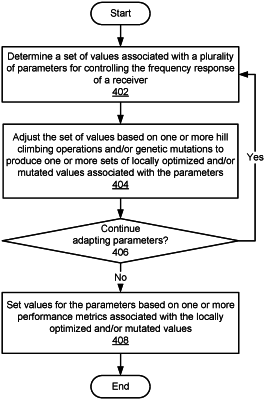| CPC H04L 27/01 (2013.01) | 20 Claims |

|
1. A method for adjusting a frequency response of a receiver, the method comprising:
performing one or more stochastic gradient hill climbing operations and one or more genetic mutation operations on one or more parameters, wherein each parameter included in the one or more parameters controls at least a portion of the frequency response of the receiver;
determining that, in response to the one or more stochastic gradient hill climbing operations and the one or more genetic mutation operations, a metric has reached a local maximum or a local minimum;
determining, when the metric is at the local maximum or the local minimum, one or more values for the one or more parameters; and
configuring a transmitter based on at least a value of a first parameter included in the one or more parameters.
|